Are you planning a trip to Australia? This country, the sixth largest in the world, is safe and welcoming. It’s known for its diverse landscapes, unique wildlife, and vibrant culture. To make sure your trip is both safe and fun, it’s important to know the local customs and etiquette. This guide will give you the key “dos and don’ts” for traveling in Australia.
Key Takeaways
- Australia has strict road safety laws, including a 0.05% blood alcohol limit for drivers and penalties for speeding and using mobile phones while driving.
- Tipping is generally not expected in Australia, but can be appreciated in certain situations.
- Respect designated smoking areas and be mindful of the legal drinking age of 18 years.
- Swim between the red and yellow flags at patrolled beaches for your safety.
- Familiarize yourself with common Australian slang and the friendly use of the term “mate” to better communicate with the locals.
Introduction
Australia is a vast and diverse country. It offers travelers a mix of vibrant cities, rugged outback, and stunning natural wonders. From the famous Sydney Opera House to the majestic Uluru, Australia has a rich and diverse Australian culture. To truly enjoy and respect the local way of life, it’s key to learn about Australian customs and etiquette.
Immersing in Australia’s Distinct Landscape
Australia’s landscape is as varied as it is stunning. It’s almost as big as the United States. The country has everything from the sunny beaches of the east to the wild, remote outback in the center. Visitors will be amazed by the natural wonders that shape the Australian way of life. These include the Great Barrier Reef and the ancient rock formations of Uluru.
Embracing Local Customs and Etiquette
To have a great time in Australia, it’s important to learn about the local customs and etiquette. This means understanding the social norms, how people communicate, and the cultural details that make Australia unique. By respecting these traditions, travelers can connect with the Australian people. They’ll also appreciate the country’s rich cultural heritage more deeply.
“Australia is not a country, it’s a continent – and it’s the only one that’s a country as well.”
Transportation and Road Rules
Getting around Australia and knowing the driving rules is key for a safe trip. It’s important for visitors to understand a few things about transportation.
Driving on the Left
In Australia, cars drive on the left side of the road. This can be a big change for those used to driving on the right. It’s important to pay attention and adjust how you drive to stay safe.
Strict Enforcement of Speed Limits and Traffic Regulations
Speed limits in Australia are taken seriously, with fines up to $1,078 for not wearing a seatbelt. The speed limit on main roads is usually 110 km/h, but it’s 130 km/h in the Northern Territory. In school zones, it’s just 40 km/h. Always follow all traffic laws to avoid getting fined.
Having car insurance is a must in Australia. It helps cover costs if you cause an accident. Public transport, taxis, and rideshare services are also safe, with steps taken to protect passengers.
| Road Rule | Penalty |
|---|---|
| Texting while driving (Queensland) | $1,000 |
| Not wearing a seatbelt | Up to $1,078 |
| Speed limit on dual carriageways (except NT) | 110 km/h |
| Speed limit in school zones | 40 km/h |
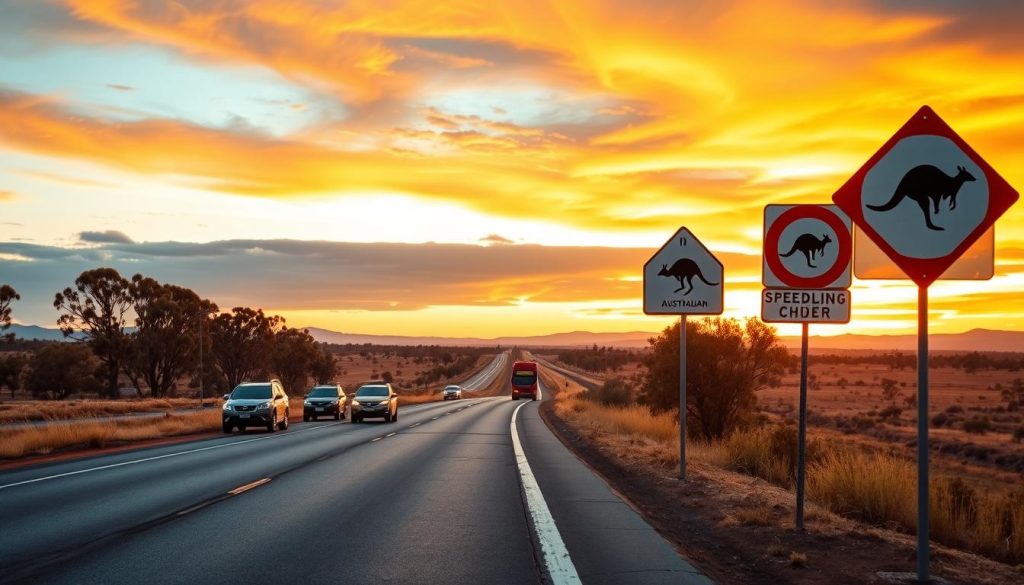
Learning about Australia’s road rules and transport can help visitors drive safely and confidently. This makes for a better trip.
Dos and Don’ts when travelling in australia
Exploring Australia’s vast and diverse landscapes means knowing the local customs and etiquette. It’s important for travelers to understand the dos and don’ts for a safe and respectful visit. By following these guidelines, you can dive into Australia’s unique culture and make lasting memories.
Dos
- Embrace the “laid-back” Australian lifestyle and be open to new experiences.
- Respect the local wildlife and keep a safe distance, especially with animals like koalas.
- Plan your road trips well, giving yourself enough time to enjoy Australia’s vastness. A trip from Sydney to Cairns or Perth to Darwin can take up to 21 days.
- Use the gas stations on your road trips for fuel, food, and facilities in one stop.
- Ask locals for dining and attraction tips to experience Australia authentically.
- Use photography to capture the stunning views and make a beautiful scrapbook of your journey.
Don’ts
- Don’t drive at night because you might hit wildlife on the roads, which is dangerous.
- Avoid shortcuts or cutting corners while driving. Australia has only one main highway with one lane in some places, leading to heavy traffic.
- Never drive under the influence. Australia has strict laws against drinking and driving, and the fines are high, ranging from $50 to $150 per fine.
- Don’t smoke in places not designated for it. Smoking is expensive in Australia, with a packet of cigarettes costing about $40 (£22).
- Don’t rush your travels. It’s important to take your time to fully experience the local culture and sights.
| Statistic | Value |
|---|---|
| Average cost of a packet of cigarettes in Australia | $40 (£22) |
| Flight time from Brisbane to Perth | Over 5 hours |
| Driving time from Brisbane to Perth | 3 days |
| Range of Australian currency notes | $5 to $100 |
| Emergency number in Australia | Triple Zero (000) |
| Range of fines for driving offenses in Australia | $50 to $150 per fine |
| Recommended minimum duration for a Sydney to Cairns or Perth to Darwin road trip | 21 days |
“Embrace the laid-back Australian lifestyle and be open to new experiences.”
Tipping and Payment Etiquette
Tipping in Australia can be different for visitors. It’s not expected here like in some other places. The country has a high minimum wage, so tips aren’t crucial for workers. Still, it’s nice to tip for great service.
When eating out, a 10-15% tip is good for the service. So, for a $100 meal, you might tip $10 to $15. For a $10 drink, $1 to $2 is usual. Hotel staff might get 10-20%, with housekeeping around $5 to $10 per stay.
Porters, concierges, and valets might get small tips too. These can be $1 AUD per bag to $10-15 AUD for the concierge. Taxi drivers don’t expect tips, but you might round up the fare.
The tipping culture in Australia is changing. More people are tipping, especially for food delivery drivers. But, tips are still less expected here than in some other countries.
Knowing about payment in Australia is also key. Cash isn’t as common as in some places. Many businesses, especially in cities, prefer electronic payments. So, having both cash and cards is a good idea for your trip.
“Tipping is not mandatory in Australia, but it’s a great way to show your appreciation for exceptional service.”
Understanding tipping and payment in Australia helps visitors travel smoothly. It makes sure they have a great time.
Drinking and Smoking Regulations
Australia has strict laws about drinking and smoking. It’s important for visitors to know these rules to avoid fines or legal trouble.
Strict Drinking and Driving Laws
The blood alcohol limit for driving in Australia is 0.05%. For learner and provisional drivers, it’s zero tolerance. Police often check for alcohol and drugs, and the consequences for driving under the influence are serious.
The Australian Guidelines suggest adults should have no more than 10 standard drinks a week. No more than 4 standard drinks on any single day is recommended. Drinking more than 4 drinks in one go is binge drinking. It raises the risk of accidents, injuries, and feeling bad the next day.
Designated Smoking Areas and Restrictions
Smoking is limited in Australia, with special areas for smokers and many public places banning it. Smoking rates have dropped from 24% in 1991 to 8.3% in 2022. In Sydney, smoking and vaping are banned in many outdoor public spots, like near playgrounds and outside eating areas.
Visitors should know the drinking laws Australia and smoking laws Australia. This helps them follow the alcohol regulations Australia and respect the Australian drinking culture.
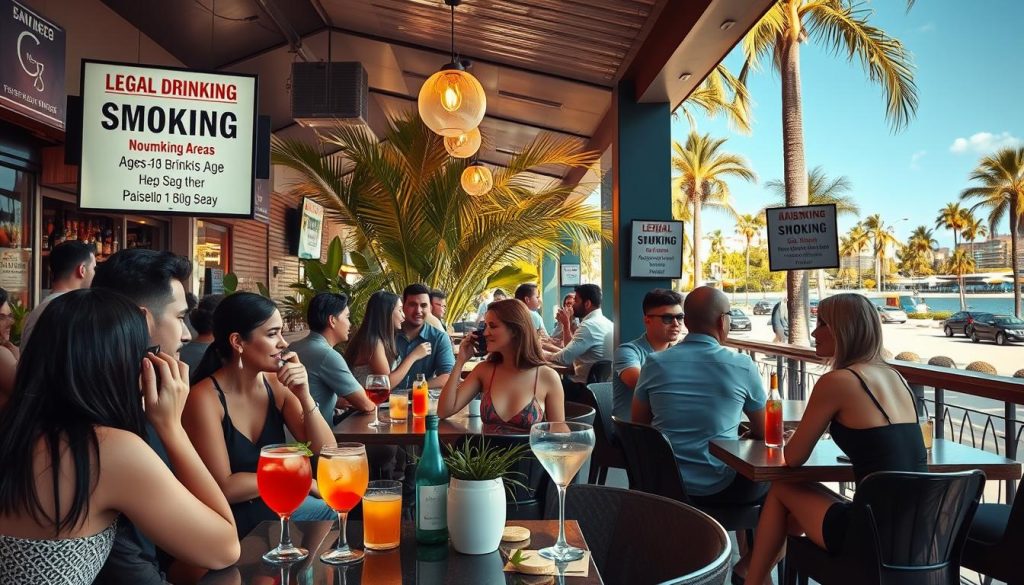
“The safest option for children and young people under 18 is not to drink any alcohol at all.”
Beach Safety
Australia is famous for its beautiful beaches, but it’s important to stay safe while swimming. Always swim between the red and yellow flags. These flags mark the safe areas where lifeguards watch over the beach. This simple rule can help avoid the dangers of rip currents, which cause about 26 deaths each year.
Rip currents are a big danger at Australian beaches. They can pull swimmers away from the shore quickly. By swimming in the flagged areas, you know lifeguards are there to help if you need it. Don’t swim outside these areas, as it can be very dangerous.
Australia’s beaches also have marine life that can be harmful to swimmers. You’ll find venomous jellyfish like the box jellyfish and irukandji in the north during warm months. Always listen to lifeguards and don’t swim if these dangerous jellyfish are around.
| Threat | Average Annual Impact |
|---|---|
| Rip currents | 26 drowning deaths |
| Shark attacks | Fewer than 10 injuries |
| Venomous jellyfish | Numerous stings, potentially life-threatening |
Follow beach safety tips and listen to lifeguards to enjoy Australia’s beaches safely. Always swim between the flags, know about marine dangers, and get advice from experts. This way, you can have a safe and fun beach trip.
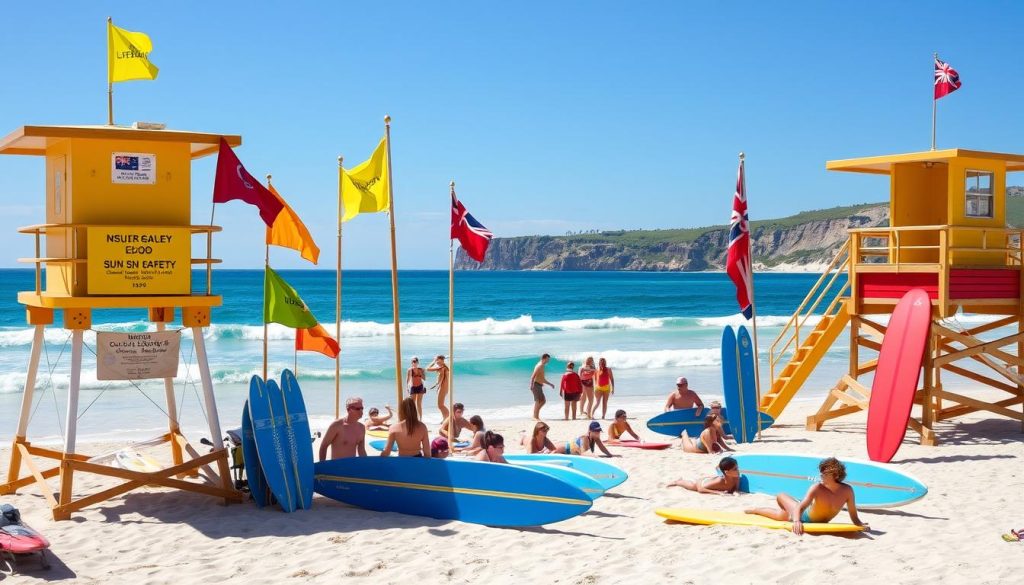
“Rips are more dangerous than shark attacks, with an average of 10 fatal shark bites globally each year.”
Wildlife Encounters
Australia is full of diverse and fascinating wildlife, from the iconic koala to dangerous species. It’s key to interact with animals responsibly. Doing so ensures a safe and fun experience for everyone.
Respecting Koalas and Other Animals
The koala is a favorite among visitors. But, it’s important not to hold or touch them. This protects the animals. Visitors should keep a safe distance and not touch other animals like kangaroos, snakes, and crocodiles either.
To have a safe wildlife experience, follow local rules and advice. Stay away from crowds and respect animals’ space. This helps you see animals without stressing them out.
Ethical Dining and Souvenirs
When eating and shopping in Australia, choose wisely. Opt for sustainable food like kangaroo, crocodile, or emu meat. This supports the local ecosystem. Also, buy souvenirs made from sustainable or recycled materials to help protect wildlife.
“Responsible interactions with Australian wildlife not only ensure the animals’ safety but also enhance the overall travel experience. By respecting the local guidelines and making mindful choices, visitors can create lasting memories while making a positive impact on the environment.”
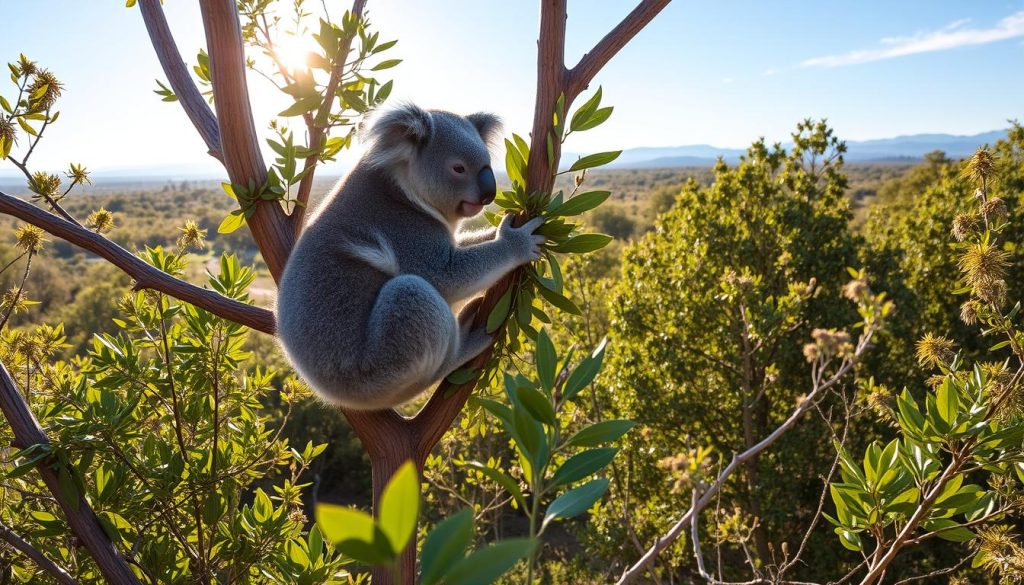
Australian Slang and Language
Australia is famous for its unique slang, which can be tricky for visitors. Aussies shorten words and use special terms. This reflects the country’s relaxed and casual vibe.
Common Slang Words and Phrases
Australians love to shorten words and add an “o” to them. For example, “brekky” means breakfast and “arvo” means afternoon. They also call flip-flops “thongs,” a service station a “servo,” and a bathroom a “dunny.”
- Bogan: A term used to describe a particular type of person in Australia, often associated with specific characteristics.
- Budgie smugglers: A slang term for male underpants that are recognizable in Australia.
- Stubby holder: A neoprene sleeve used to keep beer cold, with its own unique slang terminology.
Proper Use of the Term “Mate”
“Mate” is a big part of Australian culture. Men can call other men “mate,” but it’s not okay for a man to call a woman that. Knowing when to use “mate” is key to getting along in Australia.
| Slang Term | Meaning |
|---|---|
| “Oh Bloody Oath!” | An affirmation phrase used to confirm a statement or answer affirmatively. |
| “True Blue” | A term used to describe a person or object of authentic Australian origin. |
| “Mad as a cut snake” | A slang expression used to describe extreme anger or madness. |
Learning Australian slang can make your trip better and help you fit in. Get to know common terms and how to use “mate” right. This will make navigating Australia’s unique language easier.
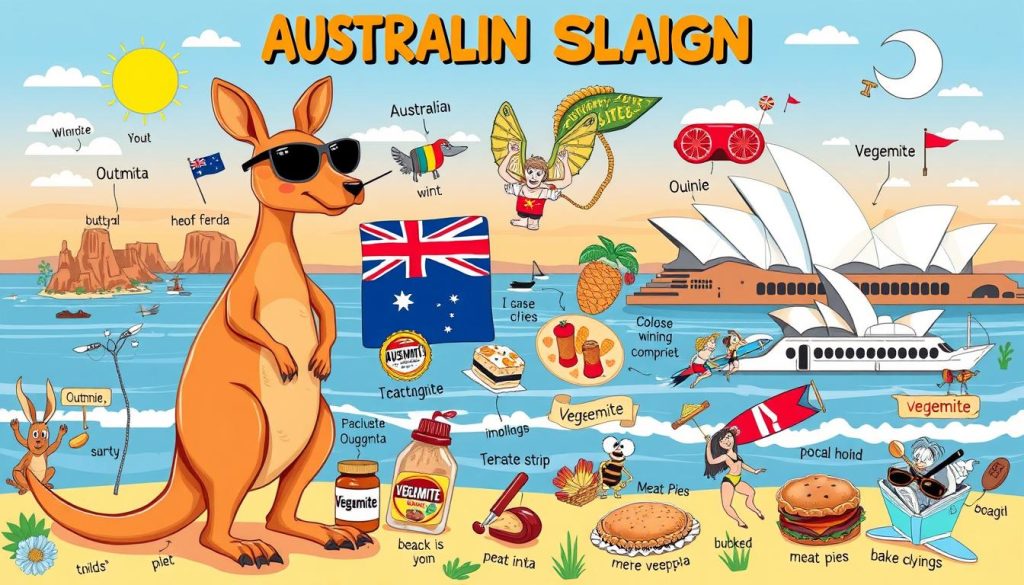
Coffee Culture
Australian coffee culture is known for its top-notch quality, creativity, and variety. Unlike many places where big coffee chains rule, Australians love their independent cafes and expert baristas. When you visit Australia, you’ll dive into a coffee world full of great choices.
Melbourne is the coffee heart of Australia. It’s packed with cafes in the city center and suburbs. People in Melbourne are known for their refined coffee tastes. Baristas there often have formal training and lots of experience, making sure every cup of coffee is perfect.
A small coffee in Melbourne costs between $3.50 to $5.00, which is a bit pricey. But the quality and skill put into each cup make it worth it. If you’re watching your budget, ask the baristas for advice. They’re eager to help you find the perfect coffee.
Exploring different cafes is a great way to see the variety of Australian coffee. You’ll find everything from traditional espresso drinks to unique local favorites. For a budget-friendly option, check out deals on Groupon for Melbourne’s top coffee spots.
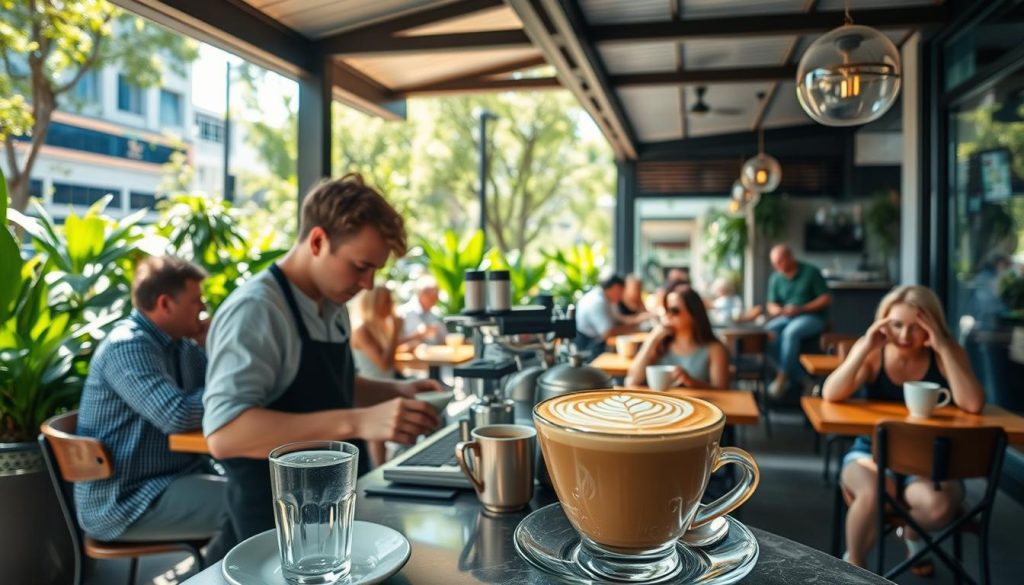
“Australia arguably invented the ‘flat white’ coffee in 1985, surpassing New Zealand for this mantle.”
The love for coffee in Australia came from European immigrants, especially from Italy and Greece, who introduced espresso and cafe culture in the 1930s and after World War II. The growth of the coffee scene in the 1980s, with the gentrification of inner-city suburbs, made it even bigger.
If you love coffee or just want a great caffeine boost, experiencing Australian coffee culture is a must. With skilled baristas and a wide range of coffee styles, it’s a treat for your senses.
Outdoor Activities and Clothing
Australia’s warm climate and beautiful landscapes are perfect for outdoor fun. But, the strong UV rays can be a big risk, especially for newcomers. To stay safe and have fun, it’s key to follow the “Slip Slop Slap” sun safety campaign.
Slip Slop Slap: Your Guide to Sun Protection
The “Slip Slop Slap” campaign tells you to slip into a shirt, slop on sunscreen, and slap on a hat when you’re outside. This advice is simple but powerful. It helps protect you from harmful UV rays and lowers the risk of sunburn, skin damage, and skin cancer.
- Slip on a shirt: Choose lightweight, long-sleeved clothing to cover your skin and protect it from the sun’s rays.
- Slop on sunscreen: Apply a generous amount of broad-spectrum sunscreen with an SPF of 30 or higher, and reapply every two hours, or more frequently if swimming or sweating.
- Slap on a hat: Wear a wide-brimmed hat to shield your face, neck, and ears from the sun.
Following the “Slip Slop Slap” guidelines lets you enjoy outdoor activities Australia offers while keeping you safe from the sun. This means you can have fun and stay Australian sun safe and sun protected.
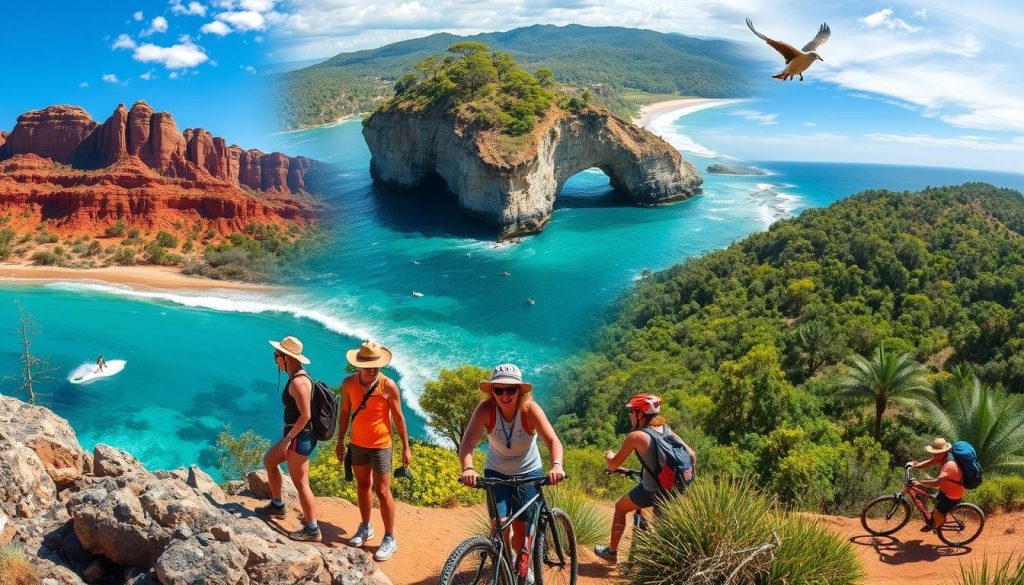
“Slip, Slop, Slap – it’s the easiest way to stay sun smart and enjoy the great Australian outdoors.”
Protecting yourself from the sun is more than just about avoiding sunburns. It’s about lowering your risk of long-term skin damage and skin cancer. So, adopt the Slip Slop Slap campaign and make it a key part of your outdoor adventures in Australia.
Unique Australian Foods
Australia’s food scene is a treasure trove for visitors, offering a mix of unique and local flavors. From the famous Vegemite spread to exotic options like kangaroo and crocodile, trying these foods is a key part of the experience. It’s a chance to dive into the heart of Australian food culture.
Vegemite is a staple in Australian cuisine, a savory spread made from yeast. It might be new to some, but it’s versatile and loved by many. You can put it on toast, in sandwiches, or use it in recipes.
Australia also offers a wide range of unique foods. Kangaroo meat is lean and packed with nutrients, becoming more popular every year. Crocodile is another unique meat that offers a distinct taste.
Don’t miss out on the meat pie, a pastry filled with meat and gravy. Or the lamington, a sponge cake covered in chocolate and coconut. These foods are key to Australian culture and enjoyed at many events or as snacks.
Trying these unique foods is a chance to explore Australia’s culinary world. With an open mind, you can fully appreciate the country’s food culture. It’s a way to connect with the nation’s vibrant culinary traditions.
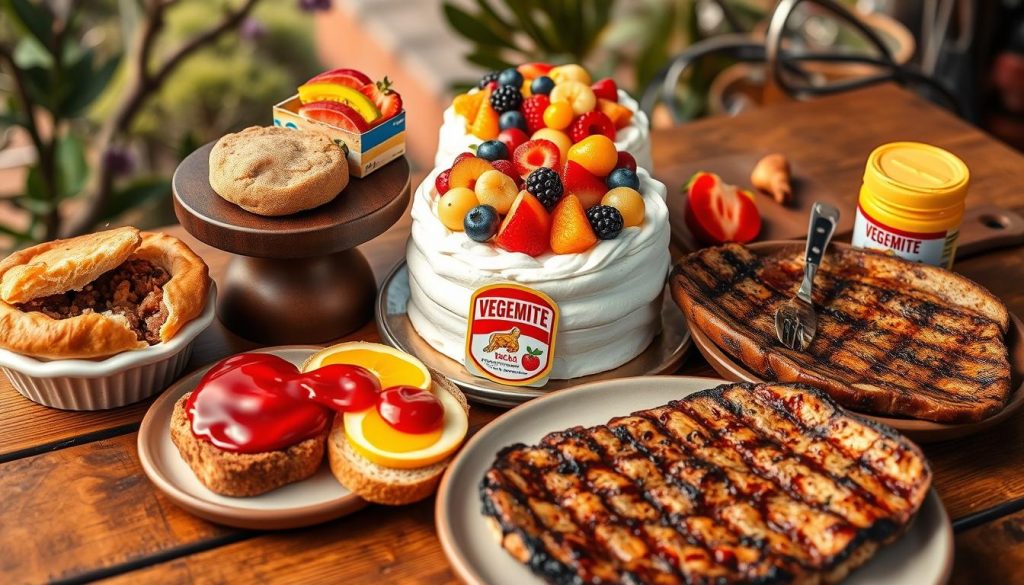
| Unique Australian Food | Description |
|---|---|
| Vegemite | A savory yeast-based spread that has become an iconic part of Australian cuisine. |
| Kangaroo Meat | A lean and nutrient-rich protein that is gaining popularity in Australia. |
| Crocodile | An unique and flavorful alternative to traditional meats. |
| Meat Pie | A savory pastry filled with minced meat and gravy, a cultural staple in Australia. |
| Lamington | A sponge cake coated in chocolate and coconut, referred to as the “National Cake of Australia”. |
“Sampling the unique and diverse array of Australian cuisine is a must-do activity for any traveler to the country.”
Carrying Identification
When you visit Australia, always keep your ID ready. Clubs and pubs might ask for it to check you’re 18. A passport or other ID in Australia can prevent problems at age-restricted places.
For identification requirements Australia, if you’re from the U.S. or Canada, bring a valid passport. If you’re a lawful U.S. permanent resident, don’t forget your passport and green card. Some countries like Australia, Japan, and the U.K. need an Electronic Travel Authorization (eTA) for flights to Australia.
- Canadian citizens, including dual citizens, need a valid Canadian passport.
- U.S. citizens must carry proper identification such as a valid U.S. passport.
- Lawful permanent residents of the United States must show a valid passport from their country of nationality and a valid green card.
- Travelers from countries like Australia, Japan, France, Germany, and the United Kingdom may need an Electronic Travel Authorization (eTA) to board their flight to Australia.
- Visa-required travelers who must obtain a visa to come to Australia include citizens of countries such as India, China, Russia, and Brazil.
Always keep your ID safe and easy to get to, especially at places where you need to be 18. Having the right identification requirements Australia makes your trip smooth and fun in this amazing country.
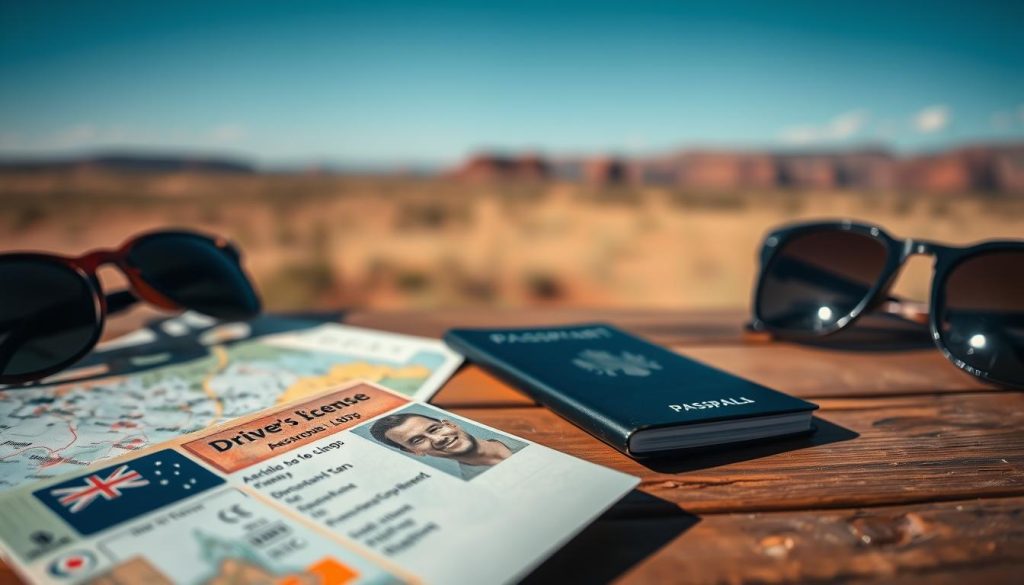
Respecting Indigenous Culture
Australia is home to diverse and ancient Indigenous cultures. These include the Aboriginal and Torres Strait Islander peoples. They are the original custodians of the land. Visitors should approach them with respect and a desire to learn.
It’s important to learn about their customs and traditions. Avoid actions that could be seen as disrespectful. Always ask permission before taking photos, as some places or ceremonies are off-limits.
Engaging with Indigenous culture Australia is rewarding. Look for ways to learn more, like joining Aboriginal-led tours or attending cultural festivals. Supporting Australian Aboriginal heritage initiatives is also a great way to help.
| Key Statistics | Insights |
|---|---|
| 54% of Australians in the general community express a desire to do something to improve reconciliation, while this figure is higher among Aboriginal people, at 73%. | There is a clear willingness among the broader Australian population to engage with and support Indigenous reconciliation efforts, which is even more pronounced within the Aboriginal community itself. |
| Only 29% of Australians in the general community know how they can contribute to helping, compared to 44% among Aboriginal people. | While there is a desire to support reconciliation, there is a need for better education and awareness on how individuals can actively contribute to these efforts, particularly among the non-Indigenous population. |
| Approximately one-third of Australians are aware of Australian Aboriginal history. | There is room for improvement in educating the broader Australian public about the rich and complex Australian Aboriginal heritage, which could foster greater understanding and appreciation. |
Learning from and engaging with Indigenous culture Australia helps us respect their culture more. It also helps in preserving this important part of Australia’s identity.
Preparing for Distances and Vastness
Traveling in Australia means facing its huge size and vastness. It’s the sixth-largest country, with big distances between cities and places. For example, driving from Sydney to Cairns takes over 27 hours.
Knowing how big Australia is helps with planning a trip. The country has everything from lush rainforests to dry outback. Understanding these distances helps manage your time and makes the trip less stressful.
The Vastness of Australia
- Australia is the sixth-largest country in the world, covering an area of 2,970,000 square miles (7,692,024 square kilometers).
- The country’s vast distances can be daunting, with a drive from Sydney to Cairns taking over 27 hours.
- Exploring the Australian landscape can be rewarding, but it requires proper planning and an appreciation for the country’s sheer size.
| Destination | Distance | Travel Time |
|---|---|---|
| Sydney to Melbourne | 877 km (545 miles) | 9 hours |
| Melbourne to Adelaide | 727 km (452 miles) | 7.5 hours |
| Adelaide to Perth | 2,768 km (1,720 miles) | 27 hours |
| Perth to Darwin | 3,279 km (2,036 miles) | 34 hours |
Understanding Australia’s size and distances helps plan your trip better. Whether by car, train, or plane, being ready for the Australian landscape makes your journey memorable and fun.
Conclusion
Australia is a captivating place full of unique experiences for travelers. This Australia travel guide shares essential dos and don’ts. It helps visitors have a safe, respectful, and fun Australia vacation.
It covers everything from getting around and following road rules to enjoying local customs and food. Following these tips makes any Australia travel trip better.
Visitors can explore vibrant cities, the vast outback, or beautiful coasts. The Australia travel guide offers advice to improve the experience. It lets travelers dive into the rich culture, diverse wildlife, and stunning landscapes of Australia.
With these Australia travel tips, adventurers can start their trip to the Land Down Under with confidence. They’ll make lasting memories and appreciate this amazing country more.